
paulo otto and silvana santosHand with six fingers: some of the defects caused by the syndromepaulo otto and silvana santos
In 2004, São Paulo biologist Silvana Santos, who was beginning her post-graduate studies at the University of São Paulo/USP’s Center for Studies on the Human Genome, traveled a number of times to the State of Rio Grande do Norte. She was the main person responsible for identifying a hitherto unknown neurodegenerative disease, whose acronym is Spoan, in Serrinha dos Pintos, an inner-state town of 4,300 inhabitants (see Pesquisa FAPESP nº 113). Four years later, the researcher identified another genetic disease not described in medical literature, in Riacho de Santana, another small town in the state, located 60 kilometers away from Serrinha. This is a new syndrome, identified in six members of a family; the syndrome’s main characteristic is congenital malformation. The absence of the fibula (perinea), the long bone located on the side of the leg, and an atrophied thigh, stunt the growth of the patient, who grows to a maximum height of 1.50 meters. The hands and the feet are twisted, the patient may have missing fingers or additional fingers and the nails have tiny defects. A description of the syndrome was published in the December 15 issue of the American Journal of Medical Genetics.
Other degenerative diseases cause some of the characteristics provoked by the Riacho de Santana syndrome, but not in all of the afflicted patients. Because of this peculiarity, the clinical condition identified in the second town, which also has a population of 4.300 inhabitants, was recognized as being a new pathology. The technical name of this disease is agenesis/hypoplasia of the fibula associated with oligodactylous syndrome and other defects. “This disease differs from other diseases because of tiny details,” says physician and geneticist Paulo Otto, from USP’s Biosciences Institute/IB, who provided the clinical description of the syndrome and co-authored the referred article. “But we immediately suspected that this was something new.” The syndrome’s effects do not alter the afflicted person’s cognitive ability. “The patients are normal in this respect,” says Silvana, currently at the State University of Paraíba/UEPB, in the city of Campina Grande. In spite of the physical defects, the patients lead relatively normal lives and adapt to their limitations.
Although the tradition of marrying blood relatives is still maintained in Riacho de Santana, the form of the syndrome’s hereditary transmission is unknown. Neither do researchers know whether the syndrome is associated with such marriages. The malformations are caused by a simple genetic defect, probably the mutation of a single gene, which spread to the members of the affected family (four siblings and a cousin, plus the son of one of the siblings). According to Otto, the most likely hypothesis is that this a dominant autosomic syndrome. If this hypothesis is correct, then any child who inherits one copy of the mutated gene will manifest the syndrome. “This is probably a rare disease, because otherwise it would have been found elsewhere,” says Silvana. With funding from the Conselho Nacional de Desenvolvimento Científico e Tecnológico/CNPq [national scientific and technological development council] and the help of colleagues from other universities, the researcher traveled to cities in the Northeast of Brazil with a significant population of physically disabled people and a high number of blood marriages in order to study the incidence of genetic problems.
Scientific Article
SANTOS, S. C. et al. A previously undescribed syndrome combining fibular agenesis/hypoplasia, oligodactylous clubfeet, anonychia/ungual hypoplasia and other defects. American Journal of Medical Genetics, v. 146A, no. 24, p. 3 126-3 131, 2008.

